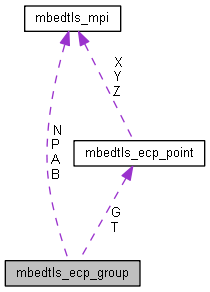The ECP group structure. More...
#include <ecp.h>

Public Attributes | |
| mbedtls_ecp_group_id | id |
| mbedtls_mpi | P |
| mbedtls_mpi | A |
| mbedtls_mpi | B |
| mbedtls_ecp_point | G |
| mbedtls_mpi | N |
| size_t | pbits |
| size_t | nbits |
| unsigned int | h |
| int(* | modp )(mbedtls_mpi *) |
| int(* | t_pre )(mbedtls_ecp_point *, void *) |
| int(* | t_post )(mbedtls_ecp_point *, void *) |
| void * | t_data |
| mbedtls_ecp_point * | T |
| size_t | T_size |
The ECP group structure.
We consider two types of curve equations:
y^2 = x^3 + A x + B mod P (SEC1 + RFC-4492) y^2 = x^3 + A x^2 + x mod P (Curve25519, Curve448)In both cases, the generator (G) for a prime-order subgroup is fixed.
For Short Weierstrass, this subgroup is the whole curve, and its cardinality is denoted by N. Our code requires that N is an odd prime as mbedtls_ecp_mul() requires an odd number, and mbedtls_ecdsa_sign() requires that it is prime for blinding purposes.
For Montgomery curves, we do not store A, but (A + 2) / 4, which is the quantity used in the formulas. Additionally, nbits is not the size of N but the required size for private keys.
If modp is NULL, reduction modulo P is done using a generic algorithm. Otherwise, modp must point to a function that takes an mbedtls_mpi in the range of 0..2^(2*pbits)-1, and transforms it in-place to an integer which is congruent mod P to the given MPI, and is close enough to pbits in size, so that it may be efficiently brought in the 0..P-1 range by a few additions or subtractions. Therefore, it is only an approximative modular reduction. It must return 0 on success and non-zero on failure.
| mbedtls_mpi mbedtls_ecp_group::A |
For Short Weierstrass: A in the equation. For Montgomery curves: (A + 2) / 4.
| mbedtls_mpi mbedtls_ecp_group::B |
For Short Weierstrass: B in the equation. For Montgomery curves: unused.
| mbedtls_ecp_point mbedtls_ecp_group::G |
The generator of the subgroup used.
| unsigned int mbedtls_ecp_group::h |
| mbedtls_ecp_group_id mbedtls_ecp_group::id |
An internal group identifier.
| int(* mbedtls_ecp_group::modp) (mbedtls_mpi *) |
The function for fast pseudo-reduction mod P (see above).
| mbedtls_mpi mbedtls_ecp_group::N |
The order of G.
| size_t mbedtls_ecp_group::nbits |
For Short Weierstrass: The number of bits in P. For Montgomery curves: the number of bits in the private keys.
| mbedtls_mpi mbedtls_ecp_group::P |
The prime modulus of the base field.
| size_t mbedtls_ecp_group::pbits |
The number of bits in P.
| mbedtls_ecp_point* mbedtls_ecp_group::T |
Pre-computed points for ecp_mul_comb().
| void* mbedtls_ecp_group::t_data |
Unused.
| int(* mbedtls_ecp_group::t_post) (mbedtls_ecp_point *, void *) |
Unused.
| int(* mbedtls_ecp_group::t_pre) (mbedtls_ecp_point *, void *) |
Unused.
| size_t mbedtls_ecp_group::T_size |
The number of pre-computed points.